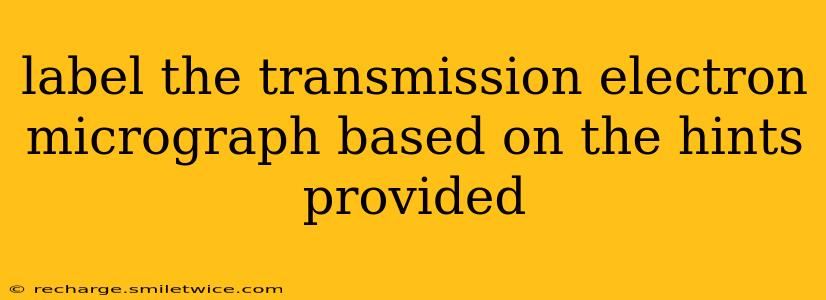Labeling Transmission Electron Micrographs: A Comprehensive Guide
Transmission electron microscopy (TEM) produces incredibly detailed images of biological samples at the nanometer scale. However, interpreting these images requires a solid understanding of cellular structures. This guide will help you effectively label TEM micrographs, even with limited hints. We'll cover common cellular components and techniques for accurate identification.
Understanding the Image: What to Look For
Before you begin labeling, carefully examine the micrograph. Consider these key features:
- Scale: Is there a scale bar? This is crucial for estimating the size of structures. Without a scale bar, estimations are difficult.
- Contrast: Darker areas often represent denser materials, like membranes or protein aggregates. Lighter areas usually indicate less dense regions, like the cytoplasm.
- Shapes and Structures: Identify characteristic shapes. Are there membrane-bound organelles? Do you see any repeating patterns? These clues are vital for identification.
- Hints Provided: Carefully analyze all hints provided. Even seemingly minor details can be significant in guiding your identification.
Common Cellular Structures Visible in TEM Micrographs
Here are some of the most frequently observed cellular structures in TEM images, along with their typical appearances:
- Cell Membrane (Plasma Membrane): Appears as a thin, dark line surrounding the cell. Often shows trilaminar structure (three layers) under high magnification.
- Nucleus: Usually a large, round or oval structure containing darker regions (heterochromatin) and lighter regions (euchromatin). The nuclear envelope (double membrane) may be visible.
- Mitochondria: Rod-shaped or oval organelles with a characteristic double membrane structure. The inner membrane is often folded into cristae.
- Endoplasmic Reticulum (ER): A network of interconnected membranes. Rough ER (RER) appears studded with ribosomes, while smooth ER (SER) appears smoother.
- Ribosomes: Small, dark dots, often associated with the RER.
- Golgi Apparatus (Golgi Complex): A stack of flattened, membrane-bound sacs (cisternae).
- Lysosomes: Membrane-bound vesicles containing hydrolytic enzymes. Often appear as dark, membrane-bound organelles.
- Vacuoles: Membrane-bound sacs used for storage or transport. Their size and contents vary widely.
How to Approach Labeling with Hints
Let's assume you are given a TEM micrograph with limited hints. A structured approach is key:
- Analyze the Hints: Begin by carefully reading and understanding all provided hints. Each hint represents a crucial piece of the puzzle.
- Identify Major Structures: Look for the most prominent features. Start with easily identifiable structures like the nucleus, cell membrane, or large organelles.
- Use Contextual Clues: The location of structures relative to each other is important. For example, ribosomes are typically found on the RER.
- Deductive Reasoning: If a hint mentions a specific organelle, look for structures matching its characteristics.
- Iterative Process: Labeling a TEM micrograph is often an iterative process. You may refine your labeling as you discover new relationships between structures.
Example: Labeling a Micrograph of a Plant Cell
Let’s say your hints include "large central vacuole" and "chloroplasts." You would:
- Identify the cell wall (a rigid outer layer, often not easily visible in animal cell TEMs).
- Locate the large, central vacuole, a prominent, clear area occupying much of the cell's interior.
- Look for chloroplasts, typically oval-shaped organelles containing internal thylakoid membranes (which might appear as stacks of pancakes).
- Label the cell membrane, nucleus, mitochondria (if present), and other visible structures as appropriate.
Conclusion
Successfully labeling a TEM micrograph relies on careful observation, a good understanding of cellular structures, and systematic application of the given hints. By following this guide, you can improve your ability to accurately identify and label the various components within these complex images. Remember, practice is key – the more micrographs you analyze, the better you'll become at identifying cellular structures and correctly labeling them.
